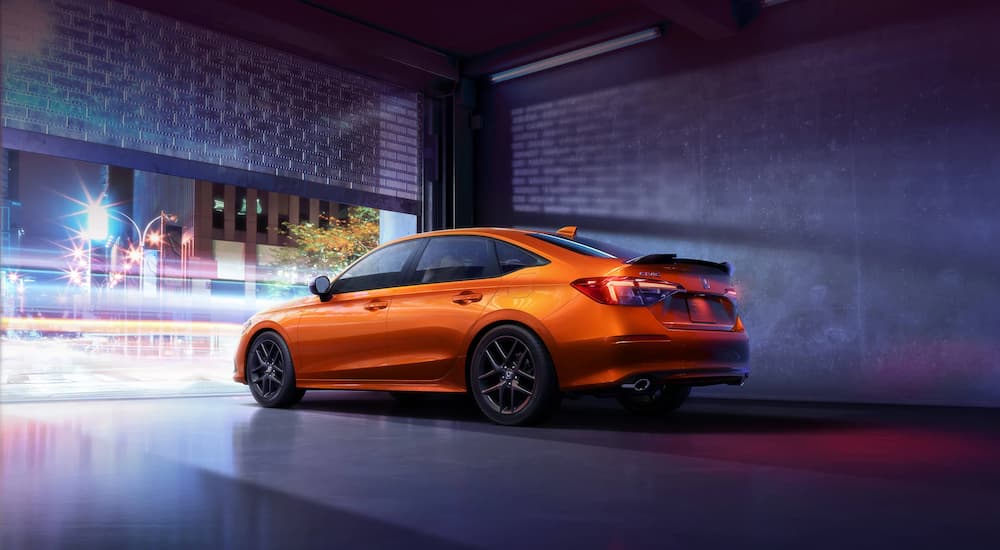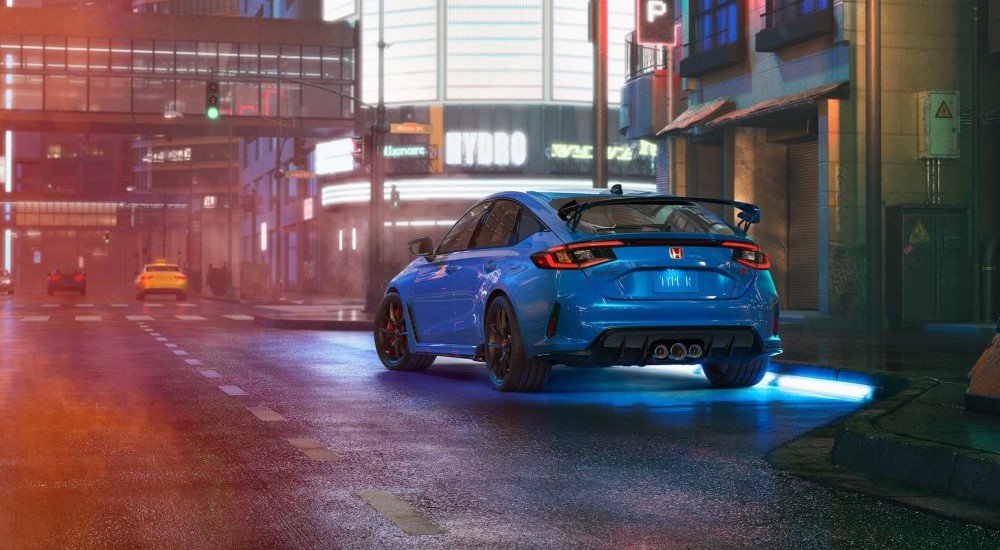There’s no denying that the Honda Civic is one of the most reliable, budget-friendly vehicles on the road today. Boasting impressive fuel efficiency and a low starting price, the Civic has earned its reputation as a dependable compact packed with value. With decades of dominance in its highly competitive segment, the car has earned its fair share of accolades, and the 2023 Honda Civic is no exception. The latest model made Car and Driver’s 10Best list, was named Motor Trend’s #1 Compact Sedan, and won Kelley Blue Book’s Compact Car Best Buy Award.
While it’s easy to focus on the Civic’s legacy for value, the vehicle has a secret double life as one of the industry’s favorite tuner cars. For those who might not be familiar with the lingo, a tuner refers to any vehicle that’s had parts modified or replaced to improve overall performance. Popular modifications include tweaks to the engine and suspension. However, many tuner cars are more instantly recognizable for the over-the-top paint jobs, wild rims, large spoilers, and other aesthetic modifications that help them stand out from the crowd.
The Civic is already an exceptionally customizable vehicle right out of the box, with a number of body styles and powerplants to choose from. But in the right hands, the Civic can easily be transformed into a thrilling ride that’s miles away from its economy car roots. What makes the Honda Civic such an ideal tuner car, and how did it become one of the gearhead community’s favorite customization projects? We’ll dive into the Civic’s history to answer all that and more.
50 Years of History
When it first launched in 1973, few could have predicted that the Civic would eventually become one of the go-to cars for the tuner community. The original Civic put fuel economy above all else, weighing 1,500 lbs and packing a mere 50 hp. The nascent Civic earned high marks for its efficiency and low starting price but was an economy car through and through. That all changed a decade later when Honda introduced the CR-X, a fastback version of the Civic that paved the way for performance-minded models to come. The CR-X Si, released in 1985, would take this one step further, boasting a 135 hp engine that––while not monstrous by any means––went a long way in improving the Civic’s power-to-weight ratio.
The Civic’s popularity and ubiquity––Honda was moving over 250,000 units annually in the US alone by the early 1990s––meant that used Civics became very easy to find. Combined with the Civic’s low starting price, that made it an intriguing prospect for tuners eager to pick up project cars on the cheap. Used Civics could be had for a steal and then easily modified, making them a favorite of gearheads worldwide. The practice was made even easier thanks to Honda’s luxury and performance division, Acura, which offered a series of high-performance engines that could easily be slotted into the Civic. Tuners could scour junkyards and classified listings for used Acura engines, drop them in a Civic, add a turbo kit, and instantly transform the stolid family vehicle into an exciting tuner car that was miles away from its original purpose.
As the Civic’s reputation grew, Honda took note and introduced a new series of powerful VTEC engines into the lineup. Honda even gave would-be tuners a blueprint to follow, releasing a special high-performance variant for the car’s sixth generation. The original 1997 Civic Type R boasted a hand-ported 1.6-liter engine with 185 hp and a 9,000 RPM redline. To make the Type R track-ready, Honda added a limited-slip differential, a seam-welded chassis, and stiff suspension, giving the Civic the hardware it needed to keep pace with the brawnier powertrain. In true tuner fashion, Honda even ripped out the sound deadening and outfitted the interior with red Recaro bucket seats and a Momo steering wheel.
What Civic to Choose?
When it comes to tuning, not all Civics are created equal. The fifth and sixth-generation models from the 1990s are often seen as the pinnacle of the Civic’s tuner era, although they are now getting long in the tooth and are more difficult to find. Further, Honda has since introduced turn-key solutions like the Civic Type R to the American market, picking up where those storied 1990s models left off. Let’s take a look at the two most recent generations to see why Honda’s humble compact remains such a star of the tuner scene.
10th Generation Civic (2016-2021)
After a couple generations spent focusing on improving the Civic’s efficiency and affordability, the 10th generation Civic broke the mold and leaned into the car’s tuner reputation with flamboyant styling and a new lineup of turbocharged engines. The high-performance Civic Type R also made its American debut in 2017, winning over tuners and casual drivers alike with its 306 hp turbocharged engine. The more common Civic Si was also offered with a turbocharged engine for the first time, a 1.5-liter powerplant that produces 205 hp stock and is durable enough to handle far more with an aftermarket tune. Even the base model Civic could be had with a turbocharger straight from the factory, although tuners quickly learned that its weaker internals are not up to supporting big power numbers.
11th Generation Civic (2022-Present)
Now in its 11th generation, the Civic is still a popular choice for tuning. While many enthusiasts were disappointed with the disappearance of the sporty two-door Civic Coupe and the elimination of the manual transmission option for the Civic Sedan, Honda hasn’t stopped catering to an enthusiast audience. The Civic Si remains true to form with a generous complement of race-ready components. The standard six-speed manual transmission with optional rev-matching allows drivers to accelerate from zero to 60 in as little as 6.6 seconds. Add larger brake rotors, performance-oriented tires, and a firmer suspension, and the Si is an alluring entry into the world of Civic tuning.
For those who will settle for nothing but the best, the 2023 Civic Type R ups the ante with a 2.0-liter engine featuring a redesigned turbocharger that produces 315 hp and 310 lb-ft of torque. That’s enough power to get the compact from zero to 60 mph in as little as 4.9 seconds. While the Type R is considerably more expensive than the base model Civic, it’s easy to see where the money went. Honda threw in a larger radiator, upgraded brake cooling, lighter flywheel to aid in rev-matching, and more. The real highlight is the Type R’s unique dual-axis front suspension, which eliminates the torque steer that normally comes with such a powerful engine and front-wheel drive. The 2023 Civic Type R also comes with Michelin Pilot Sport 4S performance tires and a striking rear wing, checking off two common tuner modifications.
A Perennial Favorite
Over the past 50 years, the Honda Civic has grown from a reliable economy car to one of the industry’s most beloved tuners. It’s an improbable story that can be credited as much to the compact’s passionate fan base as the automaker itself, but regardless of how it got here, there’s no denying the influence of the humble model. In recent years, Honda has made more than a few concessions to the tuner community, doubling down on everything gearheads love about the Civic to deliver exciting variants like the Si and Type R. The 2023 Civic is no exception, coming packed with potential and ready for the performance-minded upgrades that can inject so much fun into your everyday drive. With Honda’s reputation for reliability and quality engineering as high as ever, the Civic is sure to remain a favorite of both the tuner community and average drivers for years to come.






